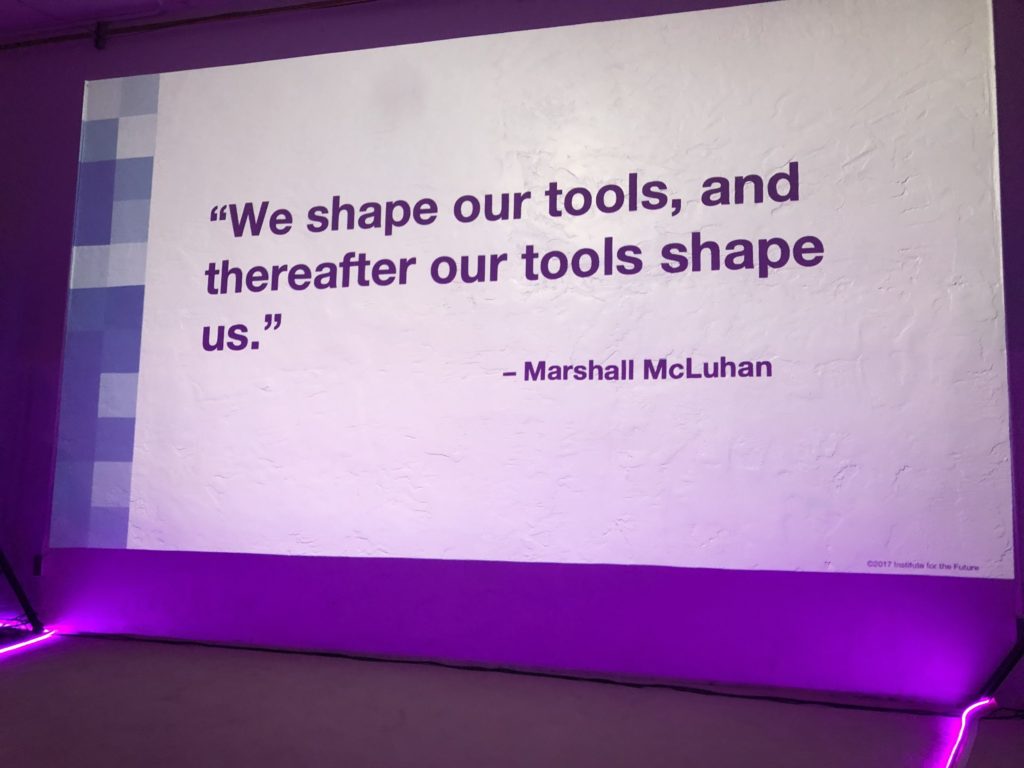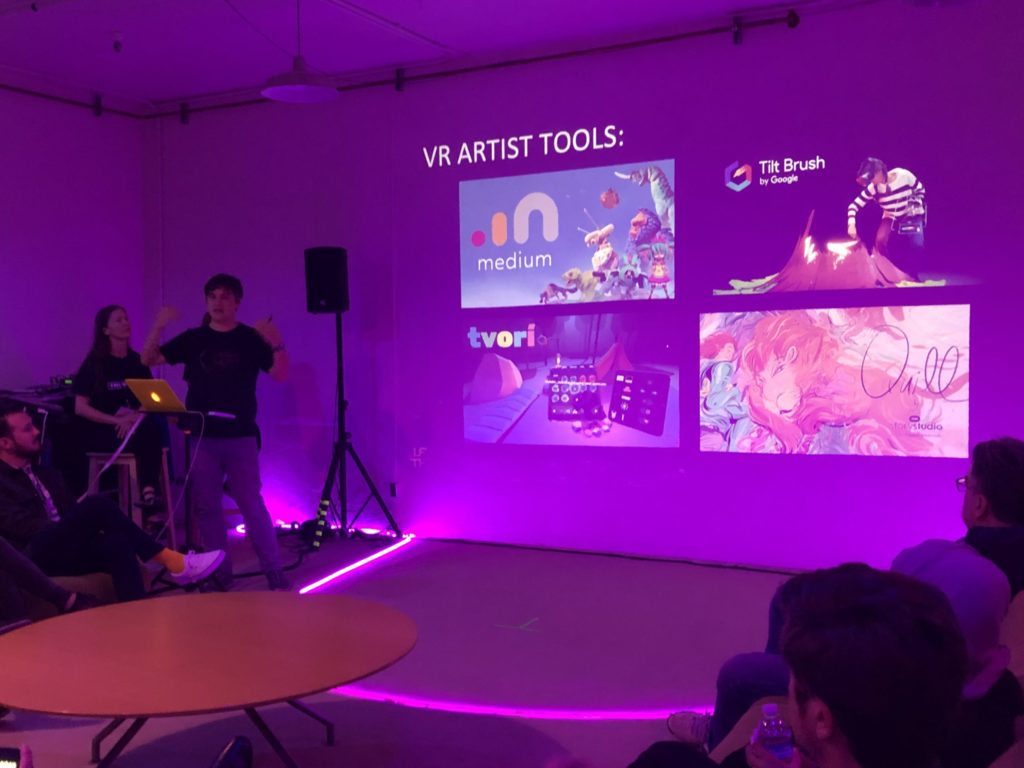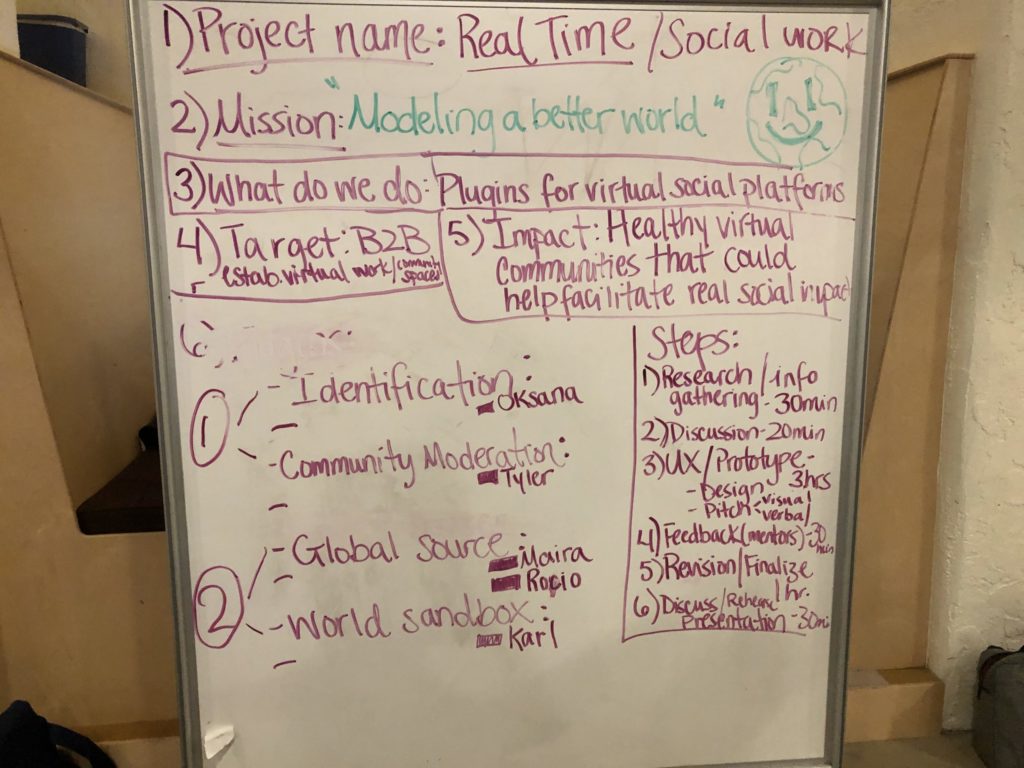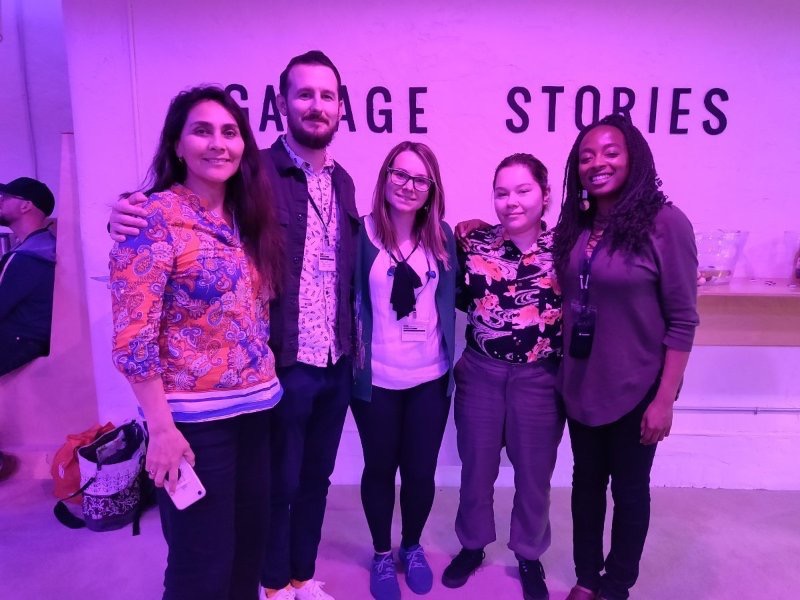Saturday, April 27th from 8am to midnight storytellers, developers, artists, and other creatives interested in XR (Extended Reality or an umbrella term for Mixed, Augmented, and Virtual Reality) were brought together at Institute for the Future (IFTF) in Palo Alto, California. Garage Stories is an organization bringing people from various fields together to create and prototype solutions for futuristic issues with specific focuses on “immersive” technology. This particular event had us focus on the question “How will XR technology shape our daily lives in 2030?”
Only 11 years away, our XR answers had to explore realistic ideas and not pretend holographic computers seen in Avenger’s headquarters was it.
Start of the Day: Breakfast and Speakers
The day began like any other event, registration and checking in at the IFTF building where they provided us breakfast. Promptly, Marta one of the founders of Garage Stories introduced herself and her team and the mission of today’s event.
Following her was the first speaker, Rachid El Guerrab, former project lead at Google Spotlights. He discussed and introduced what XR technology can do now in 2019 and how he hopes it will transform in the near future. His focus is primarily world building and entertainment using AR and VR. He described the challenges and creative ways storytelling is transformed when requiring user interaction.
Evo Heyning, founder and CEO of Exo Works, focused on her personal development and challenges using XR since its early iteration in the 90s. She developed a strong system of collaborative learning workshops through the use of immersive technologies like VR and drone piloting.
The final speaker was Maria Montenegro, Senior Interaction Designer from Magic Leap. She described the prototyping process of the Magic Leap 1 (ML1) and the difficulties of pitching this hypothetical technology to investors. One of the biggest struggles they overcame was the size of the headset being shrink down into a pocket sized device, which is impressive to their original prototype that had machines completely surrounding users.
Following the talks for team formation and explanation of the ideation session.
The not so-ideal ideation session
We got into groups and were instructed to find the mission of our group by finding the cause, target (audience), and impact of it. This was planned for ten minutes but the instructors forgot to include time for the group introductions. How are we suppose to come up with a cohesive mission statement if we didn’t know each other and skills? For my group (Team 3), most of this was spent talk about why we are interested in XR.
The ideation activity was instructed only verbally and it was a chaotic blur for me. We spent time trying to develop our idea, however this was difficult because we did not understand or hear some of the instructions thrown at us during the process. To make the situation more frustrating, mentors and hosts constantly came by, took away our focus, and asked us what we were doing (when we had no clue either). By the end of this session, we rushed into an idea of a VR social platform for group design and collaboration with alternative moderation tools.
Emerging Media Labs
After lunch, we were directed downstairs of the IFTF building and scouted our workspace. As we settled in to our areas, we were directed to a projector for a demonstration of LyraVR and what Emerging Media Labs does as part of IFTF.

“We shape our tools, and thereafter our tools shape us.” – Marshall McLuhan
This quote is one of the core principles of Emerging Media Labs, utilizing XR SDKs and headsets to develop new things beneficial to society in varying degrees and forms. Incorporating this idea into our prototypes today was important because these ideas can work in the near future.

Prototyping Session
We were given seven hours to prototype our idea to conceptualize our mission into a project that would be foreseeable in 2030. Our mission of designing a VR social platform for collaborative design evolved into an XR plugin for already established VR social platforms like Anyland, VRChat, High Fidelity, and AltSpaces that brings real world tools to facilitate social interaction and societal betterment.

This multi-faceted idea incorporates AI, blockchains, and collaborative design in order for users to solve problems. The “Identification”portion of our “Real Time” plugin uses blockchain technology to authenticate users with real world identifiers that can link their online behaviors to the real world. We hope this would add more user accountability to online social behaviors and speech along with preventing internet trolling by prevent multiple accounts being made.
Community moderation would include an AI moderator for “low priority” moderation including sexual nudity, swearing, or racial slurs. Another layer to this system would include an interactive tool kit to train selected community moderators on a restorative justice frame work and conflict resolution.
The portion of the project I worked on is the “Global Source” aspect of the plugin. This is a multi-faceted plugin utilizing AI for multiple things. The first portion is AI relaying real world news to users while in their VR platform and drawing attention to global news that users can then come together to solve within the VR space. Through scripting within VR, collaborators could script behaviors on their collaborative designs and use AI to pull open data resources in order to predict what would occur on large scales based on the collaborators designs.
Our presentation can be viewed on Google Slides.
The Final Showdown: Presentations
At 9 PM, prototyping ended and numerically by team number, teams presented their projects with various visuals. Many used videos while some groups who had developers or engineers were able to prototype within Unity and have a working model to show the audience. Each group had three minutes to present followed by a question by the judges. After deliberation, the winners were announced followed by refreshments and music.

Final thoughts?
The event was very long and structured in a way that drew focus away often from the creation aspect of the event. There were several talks that were inspiring but the mentors and hosts disrupting our conversations or asking us our pitch consistently drew away from making and more about “what is it?” As a visual creative, I was disappointed in the lack of visualization I was able to incorporate into Team 3’s prototype. I felt the disadvantage of our group was the lack of developer or Unity users that could have helped with this aspect.
Some groups had developers or engineers that could iterate designs in Unity and work with a VR headset to show their ideas more concretely. This frustrated us in the team formation since it appeared some groups needed artistic strength (which majority of my group members had) while we needed their strengths. This makes me question how the organization did the team formation.
Another interesting aspect of team formation, many groups were separated by age. Team 3, majority of us were twenty-somethings just establishing our career path and one older Architect who was also new to the XR field. Some groups had PhDs with decades of experience in healthcare, VR, game development, or software development with one or two younger people adding to the project. When grouped with similar interest, was age a factor or work experience? Wouldn’t it have been more beneficial for younger participants to team up with one experienced person rather than a team of experienced individuals? Younger participants lack the experience that older participants bring to the table, but could lose their chance of being heard in a team of experienced participants.
Aside from team formation and disruptive processing, I think for their first iteration of “Stories of the Future” it went relatively well in theme and design of the participants. These critical thoughts brought up were addressed in the evaluation Garage Stories sent to participants. This was a valuable experience for my first hackathon and laid out a foundation of what to expect at future hackathons. The learning value by participating in this event wouldn’t have been possible without the support of the College of Wooster.
